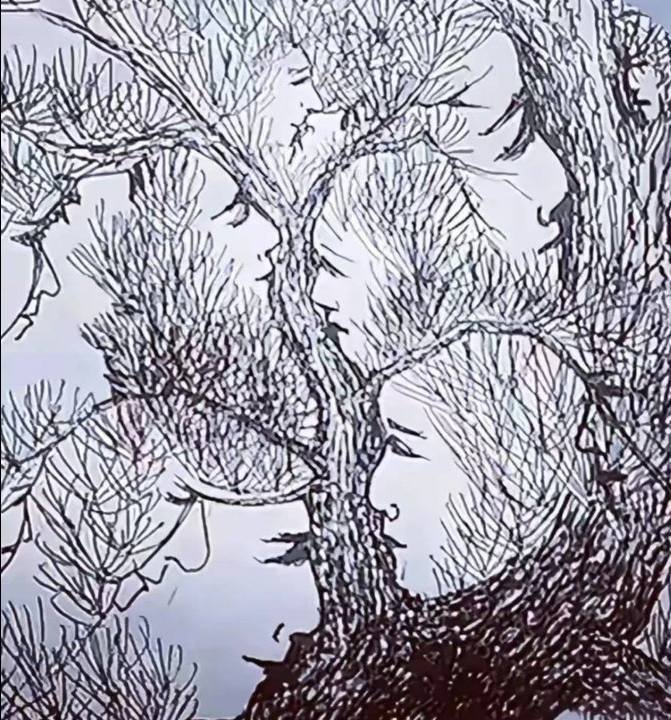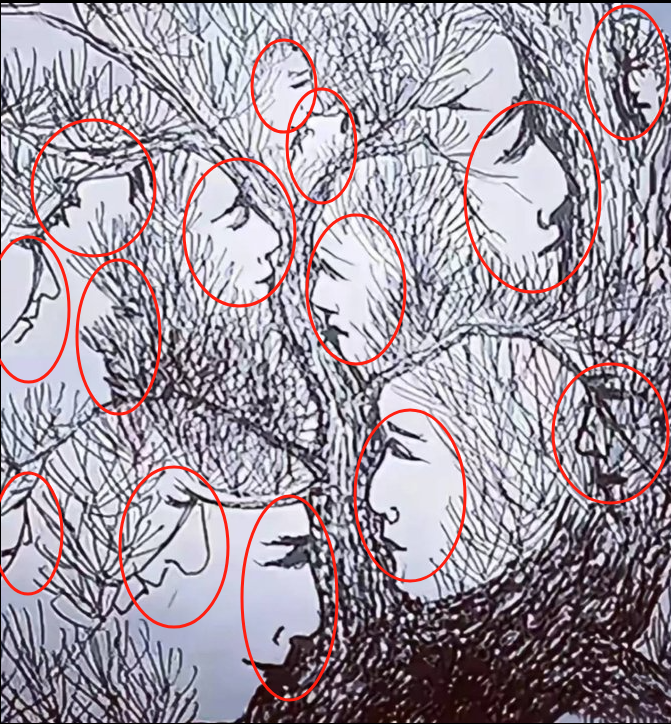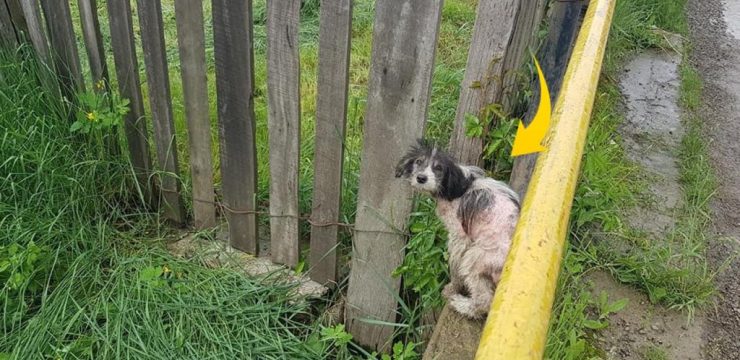Have you ever walked past an old tree and suddenly thought you saw a face peeking out from the bark or among the branches? That fleeting moment when your brain shifts from seeing random natural forms to recognizing a familiar image—often a human face—is a perfect example of nature’s optical illusions. The phenomenon is known as pareidolia, and it’s something almost all of us experience. One of the most striking examples is a beautifully illustrated tree where each twist of a branch or cluster of leaves reveals hidden human faces. This isn’t just a clever trick of the eye—it’s a fascinating intersection of psychology, creativity, and our deep-rooted connection with nature.

Understanding Pareidolia: Why We See Faces in Random Shapes
Pareidolia is the brain’s way of finding patterns, especially faces, in things that aren’t actually faces at all. It’s a survival mechanism inherited from our ancestors, who needed to quickly recognize friend or foe in the wilderness. Our brains evolved to scan environments for shapes and forms that might signal danger—or connection. Even today, this instinct is hardwired into us. That’s why we spot faces in clouds, grilled cheese sandwiches, tree bark, and even electrical outlets. In tree-face illusions, artists use this mental shortcut to create images that feel strangely familiar. With carefully placed lines and shapes, a gnarled limb becomes a brow, a bunch of leaves mimics hair, and shadows form mouths and eyes, giving us a haunting yet beautiful visual puzzle.
Discovering the Hidden Faces: A Visual Journey
At first glance, an illusion like this might just look like a tree. But with a closer look, faces begin to emerge. Near the center of the trunk, two faces—one male, one female—appear to lean toward each other, as if sharing a tender kiss. The curve of a branch forms their brows and noses, blending seamlessly into the natural design. Above them, in the thinner branches, aged faces with long beards and wrinkled features peer out like ancient guardians of the forest. Near the roots, you might find the silhouettes of two younger figures, appearing to share a whispered secret. Each new face you find feels like uncovering a hidden story—a quiet, surreal moment frozen in nature’s design.
The Artistic Craft Behind the Illusion
Creating such compelling tree illusions is no easy task. It takes a skilled hand and a deep understanding of how our eyes and brains interpret visual cues. Artists rely on several techniques to bring these illusions to life. First, they master negative space—the empty areas around objects. By leaving certain parts of the canvas or drawing blank, they can form the outline of a face using nothing more than the space between branches. Next comes texture and contour. The roughness of bark is transformed into beards, hair, and skin, while the smooth curves of limbs are reimagined as noses, cheeks, or jawlines. Finally, line weight helps build depth. Darker lines draw attention to primary faces in the foreground, while lighter, thinner strokes suggest background figures, giving the artwork a layered, three-dimensional quality.

Why We’re Drawn to These Illusions
There’s something deeply satisfying about discovering a hidden face in an unexpected place. It’s not just a visual thrill—it’s a cognitive one. Our brains love puzzles, and finding meaning in random patterns lights up reward centers, releasing dopamine and giving us a quick hit of pleasure. This makes illusions like tree faces oddly addictive. They sharpen our focus, challenge our perception, and even inspire our creativity. That little jolt of discovery can spark fresh ideas, whether you’re a writer dreaming up characters or a designer searching for inspiration.
Bringing the Illusion into Your Everyday Life
You don’t need to be lost in a forest to enjoy the magic of tree-face illusions. These enchanting images can easily become part of your home or workspace. Consider printing a large-scale tree illusion as a piece of wall art—it’ll be a conversation starter and an eye-catching centerpiece. Laser-cut wooden panels with hidden face designs can double as stylish room dividers. For something softer, look for textile prints that incorporate these illusions—on throw pillows, blankets, or even curtains. And if you’re creatively inclined, try your hand at drawing your own. Sit by a window with a sketchpad, observe the trees outside, and imagine where faces might be hiding. Let the branches guide your pencil as you turn nature’s lines into expressive features.
How to Make Your Own Tree-Face Artwork
Creating your own tree-face illusion can be both fun and fulfilling. Start by choosing a strong reference image—a tree with lots of twists and texture. Sketch out where your main faces will go, aligning them with natural contours of the tree. For instance, let a trunk become a forehead or roots form a chin. Blend the features subtly so they don’t jump out at first glance. Then, add smaller, lighter faces in the background using finer lines and less detail. Finally, use negative space to define key facial elements and refine the illusion until it all flows naturally.
The Deeper Meaning Behind These Faces
While the visual trick is fun, tree-face illusions often resonate on an emotional level too. They speak to our longing for connection—not just with people, but with nature itself. Each face feels like a silent observer, holding stories that haven’t been told yet. These hidden profiles remind us that there’s more to the natural world than meets the eye. Behind every tree, every leaf, there might be a secret waiting to be discovered. They also reflect our own inner lives, full of layers, memories, and emotions we don’t always show on the surface.
In Conclusion: Embrace the Enchanted Forest
Optical illusions in nature, like faces hidden in trees, invite us to slow down and see the world through a different lens. They merge artistic creativity with the beauty of the natural world, creating a space where imagination and reality blend. Whether you’re admiring a detailed drawing, noticing a shape in a cloud, or sketching your own tree-face creation, you’re participating in a timeless dance between perception and wonder. So next time you pass an old tree, take a second look—who knows what silent faces might be looking back.







